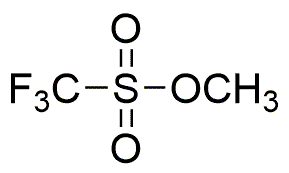Methyl trifluoromethanesulfonate is widely utilized in research focused on:
- Synthetic Chemistry: This compound serves as a powerful reagent for the synthesis of various organic compounds, enabling researchers to create complex molecules efficiently.
- Pharmaceutical Development: It is used in the production of active pharmaceutical ingredients (APIs), where its unique properties help in modifying drug structures for enhanced efficacy.
- Fluorination Reactions: Methyl trifluoromethanesulfonate acts as a fluorinating agent, allowing for the introduction of fluorine into organic compounds, which can improve their biological activity.
- Polymer Chemistry: In the field of materials science, this chemical is employed to modify polymers, enhancing their thermal and chemical stability for various applications.
- Environmental Applications: It is also explored in the development of environmentally friendly solvents and reagents, contributing to greener chemistry practices.
General Information
Properties
Safety and Regulations
Applications
Methyl trifluoromethanesulfonate is widely utilized in research focused on:
- Synthetic Chemistry: This compound serves as a powerful reagent for the synthesis of various organic compounds, enabling researchers to create complex molecules efficiently.
- Pharmaceutical Development: It is used in the production of active pharmaceutical ingredients (APIs), where its unique properties help in modifying drug structures for enhanced efficacy.
- Fluorination Reactions: Methyl trifluoromethanesulfonate acts as a fluorinating agent, allowing for the introduction of fluorine into organic compounds, which can improve their biological activity.
- Polymer Chemistry: In the field of materials science, this chemical is employed to modify polymers, enhancing their thermal and chemical stability for various applications.
- Environmental Applications: It is also explored in the development of environmentally friendly solvents and reagents, contributing to greener chemistry practices.
Documents
Safety Data Sheets (SDS)
The SDS provides comprehensive safety information on handling, storage, and disposal of the product.
Product Specification (PS)
The PS provides a comprehensive breakdown of the product’s properties, including chemical composition, physical state, purity, and storage requirements. It also details acceptable quality ranges and the product's intended applications.
Certificates of Analysis (COA)
Search for Certificates of Analysis (COA) by entering the products Lot Number. Lot and Batch Numbers can be found on a product’s label following the words ‘Lot’ or ‘Batch’.
Numéro de catalogue
Numéro de lot/série
Certificates Of Origin (COO)
This COO confirms the country where the product was manufactured, and also details the materials and components used in it and whether it is derived from natural, synthetic, or other specific sources. This certificate may be required for customs, trade, and regulatory compliance.
Numéro de catalogue
Numéro de lot/série
Safety Data Sheets (SDS)
The SDS provides comprehensive safety information on handling, storage, and disposal of the product.
DownloadProduct Specification (PS)
The PS provides a comprehensive breakdown of the product’s properties, including chemical composition, physical state, purity, and storage requirements. It also details acceptable quality ranges and the product's intended applications.
DownloadCertificates of Analysis (COA)
Search for Certificates of Analysis (COA) by entering the products Lot Number. Lot and Batch Numbers can be found on a product’s label following the words ‘Lot’ or ‘Batch’.
Numéro de catalogue
Numéro de lot/série
Certificates Of Origin (COO)
This COO confirms the country where the product was manufactured, and also details the materials and components used in it and whether it is derived from natural, synthetic, or other specific sources. This certificate may be required for customs, trade, and regulatory compliance.


